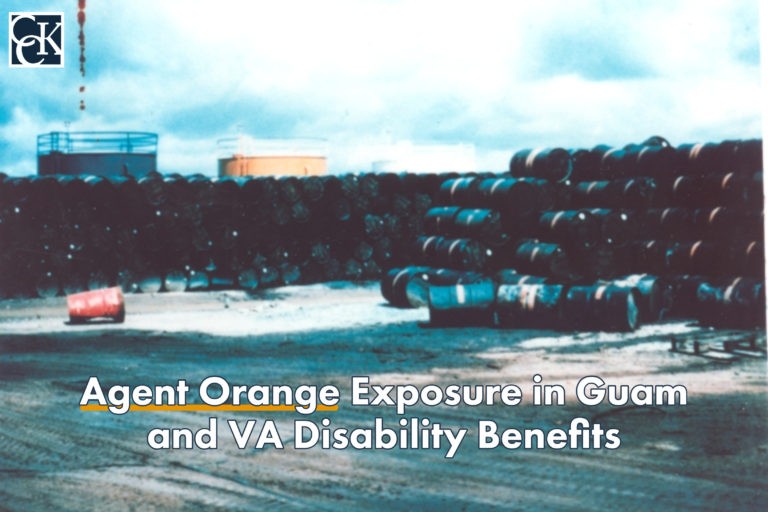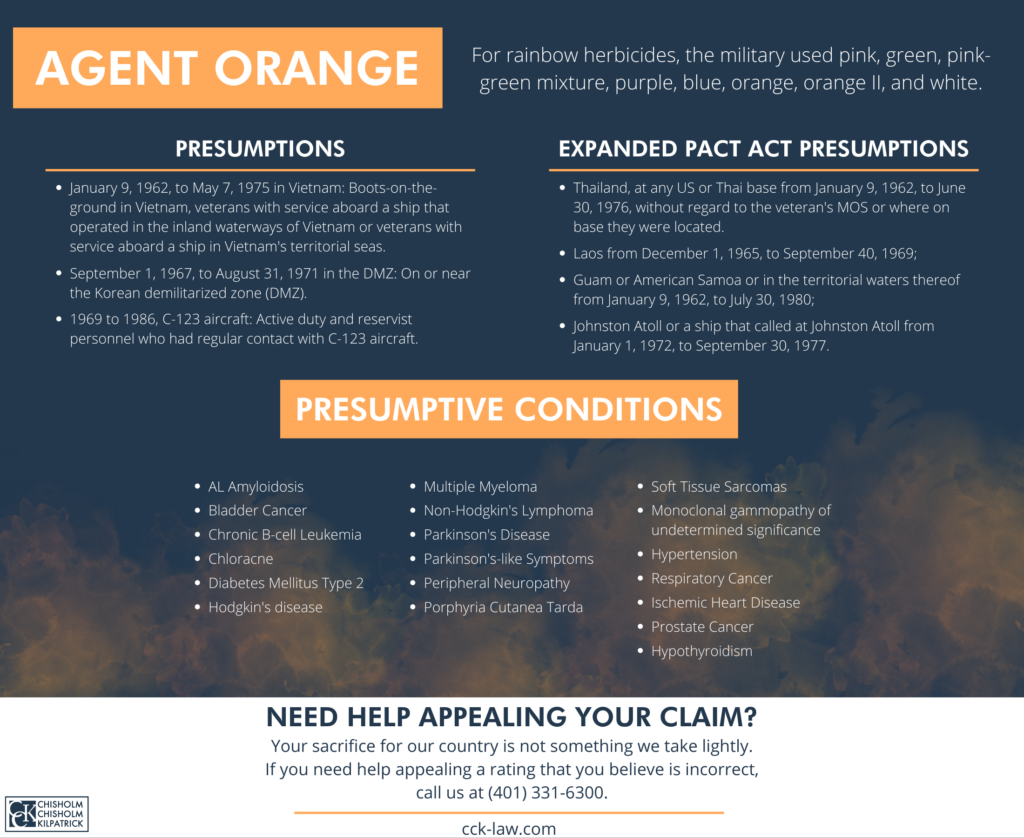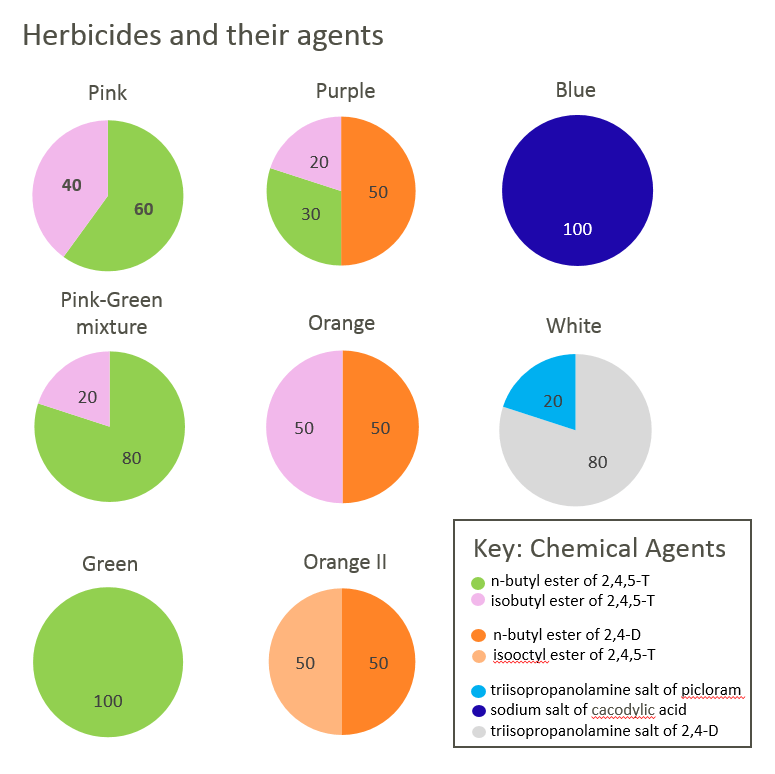Agent Orange Exposure in Guam and VA Disability Benefits

CCK Law: Our Vital Role in Veterans Law
During the Vietnam War, the United States sprayed millions of gallons of herbicides across Vietnam to destroy enemy cover and to interrupt the enemy’s food supply. These herbicides have caused a slew of health conditions in veterans who were exposed to them. While Agent Orange is most publicly associated with Vietnam, there has been growing concern related to its use and storage in other locations, including Guam.
What is Agent Orange?
Agent Orange is one of several herbicides, sometimes referred to as “rainbow herbicides,” that were used during the Vietnam War era. The herbicides were used by the United States military to deforest large areas of land, interrupt enemy food supplies, increase visibility, and prevent ambush attacks against US service members. Many veterans came into contact with Agent Orange, including those who served in areas other than Vietnam.
Specifically, Agent Orange was a mixture of two different kinds of highly toxic chemicals: 2, 4-D and 2, 4, 5-T. The highly toxic dioxin contaminant known as 2, 3, 7, 8-TCDD is a byproduct that is produced by Agent Orange. Today, we are aware of the significant health effects related to herbicide exposure.
Service Connection Due to Agent Orange Exposure in Guam
The Agent Orange Act of 1991 required VA to create a presumption of exposure for which VA will presume that veterans who served in specific locations during defined timeframes were exposed to herbicides. Presumptions of exposure help replace the element of service connection that requires veterans to have an in-service event that caused their condition. In these instances, VA counts the in-service exposure as the event.
As of the Honoring Our Promise to Address Comprehensive Toxics Act (PACT Act) of 2021, VA presumes that veterans who had active military, naval, air, or space service in the following locations during the specified timeframes were exposed to Agent Orange:
- The Republic of Vietnam from January 9, 1962 to May 7, 1975 (including Brown Water veterans and Blue Water veterans);
- Thailand, at any US or Thai base, from January 9, 1962 to June 30 1976, without regard to the Veteran’s MOS or where on base they were located;
- Laos from December 1, 1965 to September 30, 1969;
- Cambodia, specifically at Mimot or Krek, Kampong Cham Province from April 16, 1969 to April 30, 1969;
- Guam or American Samoa or in the territorial waters thereof from January 9, 1962 to July 30, 1980;
- Johnson Atoll or a ship that called at Johnston Atoll from January 1, 1972 to September 30, 1977;
- On or near the Korean demilitarized zone (DMZ) between September 1, 1967 and August 31, 1971;
- Active duty and reservist personnel who had regular contact with C-123 aircraft between 1969 and 1986.

How was Agent Orange Used in Guam?
Tens of thousands of servicemembers served in Guam during the Vietnam War era, especially at the height of the bombing operations during the conflict.
More than three-quarters of all US B-52 aircrafts that were available for operations were based in Guam. Due to the rapid build-up of United States’ air power in Guam, along with the climate conditions on the island and other conditions, Agent Orange was used to control tropical growth. In this way, Agent Orange was used similarly in Guam to how it was in Vietnam.
Locations in Guam Where Herbicides Were Used
According to private, government records and historical archives, there is evidence that Agent Orange was used during the Vietnam War Era. Evidence indicates that Agent Orange was used in the following places:
- Guam cross-island fuel pipeline and road
- Andersen Air Force Base (AAFB) and AAFB annexes and perimeters
- The Marianas-Bonins Command (MARBO) Annex
- AAFB flight line and surrounding areas
- USAF or U.S. Navy fuel storage facilities
- USAF or U.S. Navy power stations
- Areas near Urunao Beach or Ritidian Point
- Military landfills, waste piles, and over-the-cliff dumpsites
- Fire-fighter training areas
- Polaris Point and submarine tender support facilities
This list, however, is not exhaustive. More research into the subject could reveal the use of Agent Orange and other herbicides in more locations on Guam. As such, veterans who served in Guam in other areas may still have been exposed.
The Myth of Tactical vs. Commercial Herbicides
Available records show that DoD stored and used “commercial” herbicides in Guam, possibly including those that contain components of Agent Orange, during the 1960s and 1970s. Those documents do not indicate the use of “tactical” herbicides in Guam. The distinction is a myth, concocted decades ago by the supporters of herbicide use.
VA often attempts to distinguish tactical and commercial herbicides as a basis on which to deny service connection claims based on exposure to herbicides. This practice is demonstrated when comparing claims of exposure to herbicides by veterans who served in Thailand during the Vietnam War versus veterans who served in Vietnam. Despite veterans being exposed to the same herbicide agents in both Thailand and Vietnam, VA states that the herbicides to which veterans were exposed in Thailand were “commercial herbicides” and the herbicides to which veterans were exposed in Vietnam were “tactical herbicides.” However, the environment in which an herbicide is used does not change its chemical composition. The fact remains that both groups of veterans were exposed to the same herbicide agents. VA defines herbicide agent under 38 CFR § 3.307(a)(6) as “2,4-D; 2,4,5-T and its contaminant TCDD; cacodylic acid; and picloram”.
February 2021 Updated Report on Exposure in Veterans Who Served in Guam
In May 2020, the National Veterans Legal Services program, as well as the veterans legal services clinic at Yale Law School, published their initial report indicating that veterans who served in Guam from 1962 to 1975 were at least as likely as not exposed to herbicides during their service. This exposure includes dioxin-containing herbicides other than Agent Orange, meaning the exposure is not limited to Agent Orange.
Recently, these organizations have published an updated report with new evidence. Most notably, the updated report expanded the time period for exposure to include those who served between 1958 and 1980. The report cites contamination tests conducted by the Environmental Protection Agency (EPA) and the Defense Department from the 1980s and 1990s, as well as more recent EPA directed soil samplings taken in 2020.
The soil samplings taken in 2020 were conducted to bolster results from testing done in 2018 and 2019. When the prior testing was done, the soil was only tested for 2-4-D and 2-4-5-T. These two specific herbicide agents have a relatively short half-life, meaning that they are only at detectable levels in the soil for days or months at a time after the herbicides are used, depending on the volume with which they were used. However, dioxin itself, which is a byproduct of those chemicals, is often found in the same herbicide agent and has a much longer half-life. The prior testing did not specifically test for dioxin and therefore the new round of testing was primarily conducted to look for TCDD specifically.
The new testing results ultimately showed that TCDD was found at 8 out of the 10 locations sampled. Despite its short half-life, 245t was also seen in some of these samples.

Has VA Granted Claims in Favor of Guam Veterans?
There have been favorable decisions made by the Board of Veterans’ Appeals granting veterans benefits for conditions due to exposure in Guam. These cases have been evaluated on a case-by-case basis. Many of the decisions have been based on consistent veteran testimony, specifically referencing how they were exposed during their service in Guam.
One example included in the 2021 updated report described a veteran who was responsible for pushing the herbicide barrels off cliffs into dump sites, which is one of the places research has indicated herbicides were used in Guam. In this instance, VA acknowledged exposure and awarded the veteran benefits. Through this and other examples, VA has awarded some veterans benefits based on exposure in Guam, although they have been decided on a case-by-case basis.
How Does the 2021 Updated Report Impact Veterans?
Countless veterans served in Guam during the Vietnam War era and, with the findings in this new updated report, those veterans may be eligible to be awarded benefits for the exposure they faced during their service. While there still is no presumption of exposure and veterans still have the burden of proving their condition was connected to exposure, this updated report can help bolster their claims. If a veteran who served in Guam suffers from a condition that VA already recognizes presumptively due to Agent Orange exposure, they may be able to use this research and their own testimony to prove that their condition was caused by exposure. In theory, this new report will make it easier for veterans who were exposed during their service in Guam to be awarded a grant of benefits from VA.
Additionally, VA does periodically add conditions to the list of presumptive conditions based on Agent Orange exposure. This means that any veteran who served in Guam and has a condition that is not currently on the list could have their condition added eventually.
The 2021 National Defense Authorization Act, or NDAA, recently added bladder cancer, hypothyroidism, and Parkinson’s-like symptoms to the list. In addition, the PACT Act added monoclonal gammopathy of undetermined significance (abnormal protein in the blood) and hypertension to the presumptive list of conditions for herbicide exposure.
Any Guam veteran who suffers from one of these conditions might not have sought service connection before because their condition was not on the list at the time may now have an easier time fighting for their claim.
November 2018 Update: GAO Report Addresses Agent Orange in Guam
In November 2018, the United States Government Accountability Office (GAO) released a report focusing on the actions needed to improve the accuracy and communication of information regarding the use, testing, and storage locations of Agent Orange outside of Vietnam. The House report accompanying a bill for the National Defense Authorization Act for Fiscal Year 2018 included a provision that the GAO review the government’s handling of Agent Orange on Guam. To gather information, the GAO reviewed agency policies, documents, and available archival records; interviewed Department of Defense (DoD), VA, and other agency officials; and met with a non-generalizable sample of 38 veterans and a Veterans Service Organization. In doing so, the GAO uncovered that the DoD’s official list of herbicide use, testing, and storage locations outside of Vietnam, which is posted on the VA website, is inaccurate and incomplete.
The report examines (1) information the federal government has about the procurement, distribution, use, and disposition of Agent Orange at locations in the U.S. and its territories, including Guam; (2) DoD and VA efforts to make information about where Agent Orange and its components were tested and stored available; and (3) challenges associated with Agent Orange testing in locations such as Guam.
Findings Related to Agent Orange in Guam
Available documentation indicated that at least one vessel carrying Agent Orange passed through Guam on its route to Vietnam, but such information is incomplete. Specifically, the GAO analyzed the available logbooks for 152 of the 158 shipments (approximately 96 percent) of Agent Orange to Southeast Asia and found that the vessels carrying herbicides generally made stops at both foreign and U.S. ports. However, there is no evidence to show whether any cargo was offloaded.
Therefore, while the documentation establishes that at least one ship carrying Agent Orange stopped in Guam, it does not explicitly state that it was used there. Importantly, DoD has decided to move forward with testing for the acid form of the components of Agent Orange in Guam. It is expected to complete updates for the sampling and analysis plan, field sampling, analysis, and reporting in early 2019. Specifically, DoD with the U.S. and Guam Environmental Protection Agencies are conducting testing at Anderson Air Force Base on Guam.
What did the GAO Report Find?
Generally, the GAO found that DoD’s official list of herbicide testing and storage locations outside of Vietnam lacks clarity in descriptive information; omits both testing and storage locations; and omits additional time periods covered by testing events. The GAO also recognizes that this list has not been updated in over a decade, despite a significant amount of evidence and research collected regarding its shortcomings.
Veterans Have Expressed Confusion About How to Obtain Information on Potential Exposure
While DoD and VA each have methods for communicating information to veterans and the public about Agent Orange, they do not have a formal process for communicating the most accurate available information to veterans about potential locations where they could have been exposed to Agent Orange. The list is intended to do so, but it is both inaccurate and incomplete, and DoD does not have a process for managing it. Yet since it is published multiple places on the VA website, veterans take this list to be complete and factual.
As a result, veterans may not have complete information about their risk of exposure to Agent Orange during service. Additionally, VA’s Claims Adjudication Procedures Manual section regarding Agent Orange exposure directs VA adjudicators to review the DoD list to determine whether herbicides were used and whether to concede exposure. Thus, VA may not have accurate information when making decisions on veterans’ claims related to herbicide exposure.
The GAO report concluded that the list was not as up to date as the available records would allow because DoD and VA lack clearly identified responsibilities for validating this information and criteria have not been implemented to determine which locations and dates to include on the list. However, in May of 2018, DoD and VA reportedly formed a joint Herbicide Orange Working Group to address the issues with the DoD list and identify criteria for including information on the list. More recently, in July of 2018, a DoD official noted that the group was working to identify the appropriate steps to take. However, it could not yet report any specific actions that were being implemented or provide any documentation regarding the group’s efforts.
Challenges Associated with Agent Orange Testing
The GAO report acknowledges that testing to determine whether Agent Orange was present in a certain location is challenging because the components of the herbicide degrade over time and can come from multiple sources. Again, the limitations of the available documentation make it difficult to identify which specific herbicides or components were tested, as well as when and where. More so, the lack of information makes it challenging to distinguish between small-scale and large-scale testing.
Agent Orange in Guam Testing Results
The Guam and U.S. Environmental Protection Agencies (EPA) collected samples from five subsites in off-base areas that were believed to have been exposed to Agent Orange. The final test results indicate that one sample does show traces of 2,4,5-T (a component of Agent Orange) and 2,4,5-TP (a toxic chemical also known as silvex). The soil sample, labeled TY-02, was from Tiyan Junction, located near the southern edge of the A.B. Won Pat International Airport. However, the concentrations of these toxic chemicals did not exceed U.S. EPA screening levels. In other words, the results were at non-toxic levels. Officials stated that further results are still pending.
The updated findings also clarified results of earlier testing within Anderson Air Force Base. These samples were first collected in April 2018 and sent to two labs for testing. One lab found trace elements of 2,4-D and 2,4,5-T, thereby indicating the presence of the residual form of Agent Orange in the soils tested.
Was Your VA Disability Claim Based on Agent Orange Exposure in Guam Denied?
The accredited veterans’ advocates at Chisholm Chisholm & Kilpatrick LTD have decades of experience successfully representing veterans with complex VA disability claims.
If your VA claim based on Agent Orange in Guam has been denied, contact the team at CCK today at 800-544-9144.
About the Author
Share this Post

